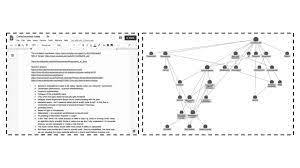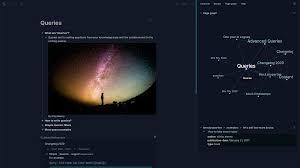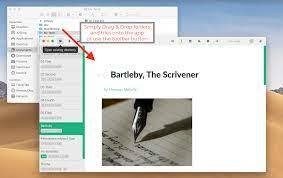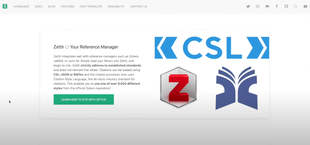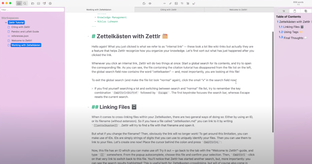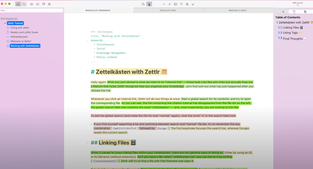Edited, memorised or added to reading queue
on 31-Aug-2022 (Wed)
Do you want BuboFlash to help you learning these things? Click here to log in or create user.
| status | not read | reprioritisations | ||
|---|---|---|---|---|
| last reprioritisation on | suggested re-reading day | |||
| started reading on | finished reading on |
Using spaced repetition systems to see through a piece of mathematics
messy and contain false turns. But I wanted to mention discovery fiction as a good example of a process which gives rise to a very different kind of understanding than the Ankification process. <span>What about other subjects? Mathematics is particularly well suited to deep Ankification, since much of it is about precise relationships between precisely-specified objects. Although I use Anki extensively for studying many other subjects, I haven’t used it at anything like this kind of depth. In the near future, I plan to use a similar process to study some of the absolute core results about climate change, and perhaps also to study some of the qualities of good writing (e.g., I can imagine using a similar process to analyze the lead sentences from, say, 30 well-written books). I don’t know how this will go, but am curious to try. I’m a little leery of coming to rely too much on the process – creative work also requires many skills at managing uncertainty and vagueness. But as a limited-use cognitive tool, deep Ankification seems potentially valuable in many areas. Follow me on Twitter Acknowledgments Many thanks to everyone who has talked with me about spaced-repetition memory systems. Especial thanks to Andy Matuschak, whose conversation has dee
| status | not read | reprioritisations | ||
|---|---|---|---|---|
| last reprioritisation on | suggested re-reading day | |||
| started reading on | finished reading on |
What Is The Best Zettelkasten Software?
n different ideas, you can increase your knowledge and become more productive while studying or researching. Several zettelkasten software programs can help you get the most out of this method. <span>1. Obsidian Price: There is a free plan available. The pay plan starts at $25, a one-time payment only Best For: Those who love drawing mind maps on a desktop computer Obsidian allows people to link their ideas together, forming a mindmap Obsidian is a powerful note-taking software with various unique, contemporary features. It allows people to link their ideas together, forming a mindmap. There is an idea placed in the center, and then each supporting idea branches off of that. Because you can link your ideas together, it is perfect for those using the Zettelkasten method. The user interface is straightforward. You can add hashtags to your notes, create footno
| status | not read | reprioritisations | ||
|---|---|---|---|---|
| last reprioritisation on | suggested re-reading day | |||
| started reading on | finished reading on |
What Is The Best Zettelkasten Software?
es that well. It runs well on Windows, macOS, and Linux, so it is a versatile program that will run well on just about every central platform; however, there is no mobile application available. <span>Pros It gives users the ability to work offline. You can create a mind map using existing markdown editor files. Highly customizable. Customer complaints are handled quickly and efficiently. Cons Not open source. You can only access it using a desktop computer. Also, the program can be a bit slow and clunky at times. 2. Roam Research Price: There is a free trial available. The paid plan starts at $100 per year Best For: Academic professionals who do a tremendous amount of research regularly Another
| status | not read | reprioritisations | ||
|---|---|---|---|---|
| last reprioritisation on | suggested re-reading day | |||
| started reading on | finished reading on |
What Is The Best Zettelkasten Software?
mizable. Customer complaints are handled quickly and efficiently. Cons Not open source. You can only access it using a desktop computer. Also, the program can be a bit slow and clunky at times. <span>2. Roam Research Price: There is a free trial available. The paid plan starts at $100 per year Best For: Academic professionals who do a tremendous amount of research regularly Another popular zettelkasten tool is called Roam Research. This is a desktop app that has been specifically designed to help people organize their ideas more effectively before writing an academic paper or essay. Furthermore, the application helps people solve problems that they might not otherwise be able to solve by uncovering patterns, which is the center of the zettelkasten method. The application is easy to use, it gives people the ability to collaborate in real-time, and the user can make new pages constantly. Then, the pages can be tied together, helping people
| status | not read | reprioritisations | ||
|---|---|---|---|---|
| last reprioritisation on | suggested re-reading day | |||
| started reading on | finished reading on |
What Is The Best Zettelkasten Software?
other note and designate that it is supposed to link to the central note. Users can quickly bounce back and forth between pages when this happens, discovering how the ideas might link together. <span>Pros It is straightforward to link ideas together. The interface is clean and does not have a lot of distractions. Users can integrate images and videos easily. The learning curve is very short. Cons There are no printing capabilities included in the program. There is no way to export documents in Docx or PDF formats. There is no web clipper available. 3. Logseq Price: Free. Donations are encouraged Best For: Those who prioritize their privacy and like making to-do lists Logseq is an open-source knowledge base management program that
| status | not read | reprioritisations | ||
|---|---|---|---|---|
| last reprioritisation on | suggested re-reading day | |||
| started reading on | finished reading on |
What Is The Best Zettelkasten Software?
The learning curve is very short. Cons There are no printing capabilities included in the program. There is no way to export documents in Docx or PDF formats. There is no web clipper available. <span>3. Logseq Price: Free. Donations are encouraged Best For: Those who prioritize their privacy and like making to-do lists Logseq is an open-source knowledge base management program that prioritizes privacy. It is used to write, organize, and distribute thoughts with others as you see fit. In addition, you can use the program to connect your thoughts as you see fit. Then, you can see your knowledge graph grow as you link various ideas together, which is supposed to represent new neurons and ideas coming together, which is a perfect example of the zettelkasten method at work. You can also use this program to organize your tasks and projects. There are commands built-in that will help you prioritize some ideas over others. There is also a query system that yo
| status | not read | reprioritisations | ||
|---|---|---|---|---|
| last reprioritisation on | suggested re-reading day | |||
| started reading on | finished reading on |
What Is The Best Zettelkasten Software?
other websites. It is less expensive than most other options. Cons It struggles if you need to produce longer papers. There is no way to create flashcards. It does not come with any templates. <span>6. Zettlr Price: Free and open-source Best For: Those who like to work in different languages The next option you might want to consider is called Zettlr. As the name suggests, this is perfect for those who want to use the zettelkasten method. This robust markdown editor contains everything you need to take notes, link ideas, and write your papers. It comes with inline previews and exceptional support, and it allows you to export in more than 40 file system formats. In addition, it maintains its functionality in more than a dozen languages. You can use this program to insert images, create charts, and even put together a slideshow. You can also drag citations from programs such as Zotero and Mendeley, making it easier to c
| status | not read | reprioritisations | ||
|---|---|---|---|---|
| last reprioritisation on | suggested re-reading day | |||
| started reading on | finished reading on |
Unknown title
such a popular concept, that there are lots of tools and software that are made and designed for it. So, this is the list of the best apps I know for doing the Zettelkasten note-taking method. <span>Zettlr The first app is Zettlr. It has been around for 3 or 4 years now. I’ve used it a few times and had a great time with it. It’s an open-source and free software with lots of features for doing Zettelkasten. Also, it got integration with reference managers like Zotero which makes it a great knowledge management tool for students and academics. I like its design — simplistic and beautiful. It feels like I’m using Safari because it’s got an almost identical interface and you can have multiple notes open as tabs which is pretty cool. Also, they have this feature that shows you the readability of your writing based on some algorithms, which can be useful if you regularly write essays and articles. Mem The second app is Mem. It’s an app that I discovered last year but haven’t got time to make a video about. It’s actually gaining lots of popularity because it’s really well made. Wh
| status | not read | reprioritisations | ||
|---|---|---|---|---|
| last reprioritisation on | suggested re-reading day | |||
| started reading on | finished reading on |
Unknown title
ify your writing and write in 3D as they say. If you’re interested in Amplenote, I have a whole playlist about it. So check it out. Read: 5 Brilliant Ways Amplenote Helps You Get More Organized <span>Roam Research Next up is Roam Research. Well, I think almost everyone knows Roam. It’s the app that made the concept of bi-directional linking popular. I know there are some people criticising Roam for various reasons, but it doesn’t change the fact that it’s a brilliant product. In Roam, each bullet is like your thinking block. You us
| status | not read | reprioritisations | ||
|---|---|---|---|---|
| last reprioritisation on | suggested re-reading day | |||
| started reading on | finished reading on |
Unknown title
lly one of the most powerful features of Roam in my opinion. Block manipulation There are lots of resources about how to use Roam and do Zettelkasten with it on my channel if you’re interested. <span>Logseq Logseq is an open-source free note-taking app that’s quite similar to Roam. There are lots of similarities, but there are some differences too. For example, it has a built-in spaced repetition system which I think is absolutely critical for any note-taking app
| status | not read | reprioritisations | ||
|---|---|---|---|---|
| last reprioritisation on | suggested re-reading day | |||
| started reading on | finished reading on |
Unknown title
re are lots of resources about how to use Roam and do Zettelkasten with it on my channel if you’re interested. Logseq Logseq is an open-source free note-taking app that’s quite similar to Roam. <span>There are lots of similarities, but there are some differences too. For example, it has a built-in spaced repetition system which I think is absolutely critical for any note-taking app for remembering what you wrote and resurfacing your old notes. Flashcards Also, it has a great PDF reader that lets you highlight and make notes about the highlights. This is great for people who have to read lots of PDF documents such as students
| status | not read | reprioritisations | ||
|---|---|---|---|---|
| last reprioritisation on | suggested re-reading day | |||
| started reading on | finished reading on |
Unknown title
king it easier for you to customise your second brain with Logseq. Plugin library Obviously, people compare Logseq to Roam, so if you’re interested in that, you can check this comparison video: <span>Obsidian Probably the most popular note-taking app right now is Obsidian. Despite it being free, it offers such a wide range of features thanks to its community plugins. I think what made Obsidian one of the most popular note taking apps in such a short period of time is its community. It’s full of amazing people, always trying to help each other and ma
| status | not read | reprioritisations | ||
|---|---|---|---|---|
| last reprioritisation on | suggested re-reading day | |||
| started reading on | finished reading on |
Unknown title
t made Obsidian one of the most popular note taking apps in such a short period of time is its community. It’s full of amazing people, always trying to help each other and make the tool better. <span>Anyway, it’s great for doing Zettelkasten. It also has a few plugins that are specifically made for that. Reflect Reflect is another great note app, but not known by many people. It kind of looks like Roam in Obsidian theme. It looks really nice, and super fast too which has been a huge iss
| status | not read | reprioritisations | ||
|---|---|---|---|---|
| last reprioritisation on | suggested re-reading day | |||
| started reading on | finished reading on |
Unknown title
the trash, walking outdoors, washing the dishes, or taking a bath. Check out The Nonlinear Library for audio-versions of content from blogs such as the EA Forum, Alignment Forum, and LessWrong. <span>2. Immersive reading Why choose between listening and reading when you can do both? Try Emerson Spartz´s #1 speed reading hack: read a book using the printed and the audible version simultaneously (that is, read with your eyes WHILE you’re also listening). By engaging two senses at once, your focus and reading speed may increase. It takes some practice, so be sure to try this method for at least a few hours before deciding if it’s right for you (people who just try it for one hour are unlikely to see a benefit). To get the full benefit, you’ll also want to push the speed of the audio to the upper edge of what feels comfortable to you. 3. Recursive sampling Use this technique to help you decide how to allocate your reading time. Instead of diving right into a book, start by reading an article about it or a review of i
| status | not read | reprioritisations | ||
|---|---|---|---|---|
| last reprioritisation on | suggested re-reading day | |||
| started reading on | finished reading on |
Unknown title
(people who just try it for one hour are unlikely to see a benefit). To get the full benefit, you’ll also want to push the speed of the audio to the upper edge of what feels comfortable to you. <span>3. Recursive sampling Use this technique to help you decide how to allocate your reading time. Instead of diving right into a book, start by reading an article about it or a review of it. Most published books have blog posts or articles about them, so this shouldn’t be too hard to do. If, based on the article or review you read, the book seems like it will be valuable, then read the first three chapters of the book. If it still feels valuable, go ahead and read the whole thing. Apply a similar method when choosing what scientific articles to read: start with the abstract if there is one. Read the conclusion or the last few paragraphs next before you read the w
| status | not read | reprioritisations | ||
|---|---|---|---|---|
| last reprioritisation on | suggested re-reading day | |||
| started reading on | finished reading on |
Unknown title
ext and diagrams helps your brain scan, synthesize and digest the information. For example, if you were learning about the Surrealist art movement, your mind map could look something like this: <span>6. Tell a friend One way to test your understanding of a topic you just learned about is to try to explain it. You could do this by explaining the idea to an interested friend, writing a blog post summarizing it, or by pretending you are teaching it to a 6th grader (this last one is sometimes known as the “Feynman Technique”). As you are doing this, you’ll likely not only end up with more clarity in your understanding, but you’ll identify important gaps in your understanding. Go back to the source material to fill in those gaps. 7. Spot the Core When learning about a complex idea, often one of the biggest challenges is figuring out the most important parts of the idea. A nice social-media method to do this is w
| status | not read | reprioritisations | ||
|---|---|---|---|---|
| last reprioritisation on | suggested re-reading day | |||
| started reading on | finished reading on |
Unknown title
oing this, you’ll likely not only end up with more clarity in your understanding, but you’ll identify important gaps in your understanding. Go back to the source material to fill in those gaps. <span>7. Spot the Core When learning about a complex idea, often one of the biggest challenges is figuring out the most important parts of the idea. A nice social-media method to do this is what we call “Spot the Core.” For the concept of interest, ask yourself — what is the most important part of this idea that I can express in one tweet? Then attempt to represent the core of that idea in just 280 characters. This forces you to focus on what is truly essential about the idea, which can deepen your understanding. A follow-up exercise once you’ve done this is to ask yourself what you would add to your first tweet if you could only use an additional 280 characters (so, two tweets worth of material). 8. Triangulating Genius Suppose you want to learn about a complex topic where experts disagree with each other. This is tricky because it’s hard to even know where to begin, or which ex
| status | not read | reprioritisations | ||
|---|---|---|---|---|
| last reprioritisation on | suggested re-reading day | |||
| started reading on | finished reading on |
Unknown title
for his work uncovering many biases in our intuition), Gerd Gigerenzer (who challenged some of Kahneman’s work), and Phil Tetlock (who examined the poor forecasting abilities of many experts). <span>Or, if you’re trying to learn about the world of investing, you might choose as your geniuses Warren Buffet (generally believed to be the greatest value investor of all time), Ray Dalio (who started what was the world’s largest hedge fund), and Nassim Taleb (a famous contrarian in finance). Once you’ve selected your experts, go ahead and read their arguments on the topic. Not only will you learn a lot from their ideas, but you can learn even more by taking note of what they agree and disagree on. The intersection points where these experts agree are the conclusions you can be most confident in. You should have less confidence in the points that they disagree on, and you’ll either have to defer judgment or form your own opinion based on the arguments each side makes. 9. Expert Observation It is quite unlikely that you can master chess just by reading books and following tutorials. Although those are a good starting point, your game will most likely
| status | not read | reprioritisations | ||
|---|---|---|---|---|
| last reprioritisation on | suggested re-reading day | |||
| started reading on | finished reading on |
Unknown title
nging set of articles on a topic that you are not familiar with, but which you are motivated to really understand. For instance, you may be trying to figure out how “deep neural networks” work. <span>Skim the articles once, making no attempt to fully understand them. The purpose at this stage is to identify the main ideas in the articles, notice what you already know and figure out the things that you need to learn about. As you do this, take notes using advanced note-taking systems like Roam and Notion. When you encounter each important seeming concept and definition, turn them into flashcards using ThoughtSaver, Supermemo, or Anki, so that you can be quizzed on the content using the methods of spaced repetition and active recall. Review these cards regularly. Make several passes through the articles this way (most likely spread over a few days or even a week), and you will notice that the flashcards you’re creating start going deeper into the topic. Once you’ve reviewed these more detailed flashcards a few times, you can now try reading the articles again, this time taking your time to try and understand them in detail. You will likely find that the concepts start to fall into place in your mind. What’s more, because of using spaced repetition, the content will likely stay in your memory much longer, and you have an easy way to brush up on the ideas at any time. Here is another set of flashcards to provide you with the key takeaways from the section “Remember More.” Part 4: PUT YOUR LEARNING INTO PRACTICE It can be really difficult to turn know
| status | not read | reprioritisations | ||
|---|---|---|---|---|
| last reprioritisation on | suggested re-reading day | |||
| started reading on | finished reading on |
Unknown title
effort. And the things you learn are only useful if they result in different outcomes. So in this final section, we’ll explore three techniques to help you take action based on what you learn. <span>13. Trigger-action plans (TAPs) One way to turn learning into practice is by associating an idea or mental model with a situation in which you would like to apply it. This can be done by forming mental habits with the structure "When situation X arises, I will perform response Y". Put differently, “When I encounter this trigger, I will perform that action”. This is what the psychological research literature calls “implementation intentions”. The Center For Applied Rationality (CFAR) instead refers to the catchier “trigger-action plans” (TAPs). The triggering situation could be just about anything; it could be something external, such as your immediate physical environment. Or it might be something internal, like a certain emo
| status | not read | reprioritisations | ||
|---|---|---|---|---|
| last reprioritisation on | suggested re-reading day | |||
| started reading on | finished reading on |
Unknown title
effort. And the things you learn are only useful if they result in different outcomes. So in this final section, we’ll explore three techniques to help you take action based on what you learn. <span>13. Trigger-action plans (TAPs) One way to turn learning into practice is by associating an idea or mental model with a situation in which you would like to apply it. This can be done by forming mental habits with the structure "When situation X arises, I will perform response Y". Put differently, “When I encounter this trigger, I will perform that action”. This is what the psychological research literature calls “implementation intentions”. The Center For Applied Rationality (CFAR) instead refers to the catchier “trigger-action plans” (TAPs). The triggering situation could be just about anything; it could be something external, such as your immediate physical environment. Or it might be something internal, like a certain emotional state. For example, you might want to associate shallow breathing or racing thoughts (trigger) with the action of closing your eyes and taking a few deep breaths to calm yourself. Or when you enter your office or apartment building, you might want to simply look at the staircase (as opposed to the elevator) to get yourself to take the stairs and get a bit of exercise. The idea is to make goal-directed behavior automatic. Ideally, by mentally associating a trigger situation with a desired action, you will effortlessly take that action once the trigger is encountered. To create new trigger-action patterns, CFAR has recommended that you mentally rehearse it a total of ten times. Yes, ten times! That is, either think or say to yourself "When situation
| status | not read | reprioritisations | ||
|---|---|---|---|---|
| last reprioritisation on | suggested re-reading day | |||
| started reading on | finished reading on |
Unknown title
is to make goal-directed behavior automatic. Ideally, by mentally associating a trigger situation with a desired action, you will effortlessly take that action once the trigger is encountered. <span>To create new trigger-action patterns, CFAR has recommended that you mentally rehearse it a total of ten times. Yes, ten times! That is, either think or say to yourself "When situation X arises, I will perform response Y" ten times. You can use ThoughtSaver to automatically remind yourself of the TAPs you’ve set. Or you can use our free Clearer Thinking tool “Program Yourself” to create new TAPs. 14. Project-based learning (PBL) A more hands-on approach to turning learning into practice is to work on a small project using the skills you are trying to learn. The advantage of PBL
| status | not read | reprioritisations | ||
|---|---|---|---|---|
| last reprioritisation on | suggested re-reading day | |||
| started reading on | finished reading on |
Unknown title
orm response Y" ten times. You can use ThoughtSaver to automatically remind yourself of the TAPs you’ve set. Or you can use our free Clearer Thinking tool “Program Yourself” to create new TAPs. <span>14. Project-based learning (PBL) A more hands-on approach to turning learning into practice is to work on a small project using the skills you are trying to learn. The advantage of PBL is that it increases your engagement with, and motivation towards learning. Additionally, it focuses your learning on skills and knowledge that you actually intend to use. For example, if you want to learn data science you can pick a project that you are particularly interested in, such as analyzing a data set about air pollution's impacts on health. You can look up the resources needed, run through some example questions on the Kaggle data science competition site, and then finally apply what you learn to a particular dataset that seems interesting to you. You make something of your own by the end of the process, creating a sense of personal achievement and satisfaction. At the same time, by using PBL you can often create tight feedback loops where you quickly get high-quality feedback on your performance (as you see where you are making progress and where you are stuck), which can dramatically speed up your learning. In addition, it helps you understand the subject matter more deeply when you put it into practice; you’re naturally encouraged to notice gaps in your understanding, as you often won’t be able to do what you’re trying to do without filling those gaps. For example, you probably won’t be able to do data science without knowing some programming. If you were just doing an online course, the temptation to simply skip content related to improving your programming skills might be too high, as the consequences of doing so might feel abstract and distant in time when you’re not putting it into practice right away. Finally, Project-based Learning can be useful as a way of combining a favorite hobby or passion with learning a desired skill set, making it more fun and engaging to learn something new. For example, if you love graphic design, you could design an infographic to complement your data analysis. You’ve just seen fourteen techniques for accelerating your own learning. We hope that you’ll take a moment right now to pick one or two of them to apply right away. You can start learni
| status | not read | reprioritisations | ||
|---|---|---|---|---|
| last reprioritisation on | suggested re-reading day | |||
| started reading on | finished reading on |
20 rules of formulating knowledge in learning
erfere with other traces making it difficult to find the exit. The same happens on the cellular level with different synaptic connections being activated at each repetition of complex material. <span>Repetitions of simple items are easier to schedule I assume you will make repetitions of the learned material using optimum inter-repetition intervals (as in SuperMemo). If you consider an item that is composed of two sub-items, you will need to make repetitions that are frequent enough to keep the more difficult item in memory. If you split the complex item into sub-items, each can be repeated at its own pace saving your time. Very often, inexperienced students create items that could easily be split into ten or more simpler sub-items! Although the number of items increases, the number of repetitions of each item will usually be small enough to greatly outweigh the cost of (1) forgetting the complex item again and aga
| status | not read | reprioritisations | ||
|---|---|---|---|---|
| last reprioritisation on | suggested re-reading day | |||
| started reading on | finished reading on |
| status | not read | reprioritisations | ||
|---|---|---|---|---|
| last reprioritisation on | suggested re-reading day | |||
| started reading on | finished reading on |
Millennials - Wikipedia
2021) Part of a series on Named generations in the Western world Lost Generation Greatest Generation Silent Generation Baby boomers Generation X Millennials Generation Z Generation Alpha v t e <span>Millennials, also known as Generation Y or Gen Y, are the demographic cohort following Generation X and preceding Generation Z. Researchers and popular media use the early 1980s as starting birth years and the mid-1990s to early 2000s as ending birth years, with the generation typically being defined as people born from 1981 to 1996.[1] Most millennials are the children of baby boomers and early Gen Xers;[2] millennials are often the parents of Generation Alpha.[3] Across the globe, young people have postponed marriage.[4] Millennials were born at a time of declining fertility rates around the world,[5] and are having fewer children than their predecessors.[6][7][8][9] Those in developing nations will continue to constitute the bulk of global population growth.[10] In the developed world, young people of the 2010s were less inclined to have sexual intercourse compared to their predecessors when they were at the same age.[11] In the West, they are less likely to be religious than their predecessors,[5][12] but they may identify as spiritual.[13] Millennials have been described as the first global generation and the first generation that grew up in the Internet age.[14] The generation is generally marked by elevated usage of and familiarity with the Internet, mobile devices, and social media,[15] which is why they are sometimes termed digital natives.[16] Between the 1990s and the 2010s, people from the developing world became increasingly well educated, a factor that boosted economic growth in these countries.[17] Millennials across the world have suffered significant economic disruption since starting their working lives; many faced high levels of youth unemployment during their early years in the labour market in the wake of the Great Recession, and suffered another recession in 2020 due to the COVID-19 pandemic.[18][19] Contents 1 Terminology and etymology 2 Date and age range definitions 3 Psychology 4 Cognitive abilities 5 Cultural identity 5.1 In the United States 5.2 In general and in other countri
| status | not read | reprioritisations | ||
|---|---|---|---|---|
| last reprioritisation on | suggested re-reading day | |||
| started reading on | finished reading on |
Where Millennials end and Generation Z begins | Pew Research Center
tered adulthood before today’s youngest adults were born. In order to keep the Millennial generation analytically meaningful, and to begin looking at what might be unique about the next cohort, <span>Pew Research Center decided a year ago to use 1996 as the last birth year for Millennials for our future work. Anyone born between 1981 and 1996 (ages 23 to 38 in 2019) is considered a Millennial, and anyone born from 1997 onward is part of a new generation. Since the oldest among this rising generation are just turning 22 this year, and most are still in their teens or younger, we hesitated at first to give them a name – Generation Z, the
| status | not read | reprioritisations | ||
|---|---|---|---|---|
| last reprioritisation on | suggested re-reading day | |||
| started reading on | finished reading on |
Where Millennials end and Generation Z begins | Pew Research Center
Millennials will be a factor in American society for decades. Technology, in particular the rapid evolution of how people communicate and interact, is another generation-shaping consideration. <span>Baby Boomers grew up as television expanded dramatically, changing their lifestyles and connection to the world in fundamental ways. Generation X grew up as the computer revolution was taking hold, and Millennials came of age during the internet explosion. In this progression, what is unique for Generation Z is that all of the above have been part of their lives from the start. The iPhone launched in 2007, when the oldest Gen Zers were 10
| status | not read | reprioritisations | ||
|---|---|---|---|---|
| last reprioritisation on | suggested re-reading day | |||
| started reading on | finished reading on |
Becoming a Superhuman | Derek Sivers
ead that? Jonathan: That’s my favorite book of all time actually. Derek: Are you serious? Jonathan: Yeah. Derek: Alright. Well, I think for anybody listening who hasn’t read it yet, you should. <span>Kicking it old school in 1930’s, I think the title is really unfortunate because it makes it sound like it’s a slimy book about how to trick people into liking you. But actually, I think it should be called How to Be Considerate because I think it’s the most amazing book about looking at everything from the other person’s point of view. And the punchline of the book is that the way to win friends and influence people is to be sincerely interested in others and always connect with them around their own interests, not yo
| status | not read | reprioritisations | ||
|---|---|---|---|---|
| last reprioritisation on | suggested re-reading day | |||
| started reading on | finished reading on |
Becoming a Superhuman | Derek Sivers
le into liking you. But actually, I think it should be called How to Be Considerate because I think it’s the most amazing book about looking at everything from the other person’s point of view. <span>And the punchline of the book is that the way to win friends and influence people is to be sincerely interested in others and always connect with them around their own interests, not yours. Jonathan: Exactly. Derek: So my little book is about that approach to business. So it sounds simple, but people tell me that it’s very counter-intuitive, especially if you’ve been immer
| status | not read | reprioritisations | ||
|---|---|---|---|---|
| last reprioritisation on | suggested re-reading day | |||
| started reading on | finished reading on |
Becoming a Superhuman | Derek Sivers
ervice to others. I mean, I guess unless you want to share a couple broader goals, what are the values that help you drive what goals you’ll set for yourself? Derek: Actually you just named it. <span>I do often find that when I get a little paralyzed over wondering what to do next, if I just ask myself this question, “Well, what’s most useful to other people?” or “How can I be of the most value to others?” that usually answers it. Of course, there are things that I’m interested in doing that aren’t directly useful to others. I do want to learn Mandarin. I think it’s fascinating. I love the Chinese writing system,
| status | not read | reprioritisations | ||
|---|---|---|---|---|
| last reprioritisation on | suggested re-reading day | |||
| started reading on | finished reading on |
Becoming a Superhuman | Derek Sivers
simple- those little morals whether it’s Ten Commandments or whatever people may have that guide them- Aesop’s Fables. They make these little things that are so easy to remember. I don’t know. <span>For me, the one I got when I was a teenager- I don’t know if I heard it from someone or if I just came up with it myself- but it was whatever scares you, go do it. Jonathan: Oh, yeah. Derek: And I’ve just been living with that almost daily since I was a teenager that just when in doubt, when faced with any situation, whatever scares you, go do it.
| status | not read | reprioritisations | ||
|---|---|---|---|---|
| last reprioritisation on | suggested re-reading day | |||
| started reading on | finished reading on |
Becoming a Superhuman | Derek Sivers
hat just when in doubt, when faced with any situation, whatever scares you, go do it. Kind of like the Santa Monica idea I said earlier where staying in Santa Monica was the comfort choice, and <span>I think Abraham Maslow, psychologist, said something about every day, we’re presented 100 times a day with a choice between safety and risk. And he said, “Make the growth choice 100 times a day” something like that. And I just love that. Even those tiny little choices that you make in the day, like what would be the choice that would help me grow as a person and what would be the choice that would
| status | not read | reprioritisations | ||
|---|---|---|---|---|
| last reprioritisation on | suggested re-reading day | |||
| started reading on | finished reading on |
Becoming a Superhuman | Derek Sivers
say that on the homepage of my site because it’s a link to my favorite fable. Should I tell it? I guess it only takes a minute. Jonathan: Yeah, sure! Derek: All right. It’s pretty widely known. <span>So I think it’s been in some movies and some other people have quoted it in their books, but it goes like this. It’s that a man and his son have a horse, and they only have one horse. And one day, their only horse runs away. And all of their neighbors come by and say, “Oh, I’m so sorry for your loss. You must be so upset.” And the man just shrugged and said, “Well, we’ll see.” And about a week later, that only horse came back and it had 20 other horses in tow. And the man and his son gathered all of these horses into the corral and suddenly they had like 21 horses, and they were like the richest people in their village. And all the neighbors came by and said, “Oh my gosh. You must be so happy. What wonderful news! You must be ecstatic.” And the man just shrugged and said, “Well, we’ll see.” And then because of these 21 wild horses, one day one of the wild horses kicked his son in the legs breaking both of his legs and suddenly, the old man’s only son was laid up in bed. The old man had to do everything himself. And the neighbors came by and said, “Oh, you must be so upset. I’m so sorry.” The man just said, “We’ll see.” And then shortly after, the country went to war and every able-bodied young man was sent off to war, and they were all killed in a horrible battle. But the man’s son was spared because his legs were broken. And the neighbors came by and said, “Oh, you must be so thankful.” The man just said, “We’ll see.” That’s it. I love that story. Jonathan: I love it. Derek: Because something I think is a core thing about myself is that I’ve always had a very long-term focus. Like even when I was- I don’t know- like 17 years old,
| status | not read | reprioritisations | ||
|---|---|---|---|---|
| last reprioritisation on | suggested re-reading day | |||
| started reading on | finished reading on |
Becoming a Superhuman | Derek Sivers
The man just said, “We’ll see.” That’s it. I love that story. Jonathan: I love it. Derek: Because something I think is a core thing about myself is that I’ve always had a very long-term focus. <span>Like even when I was- I don’t know- like 17 years old, some of my friends were starting to get tattoos like, “Man, you got to get a tattoo.” And I said, “You know, I think when I’m 90, I won’t want that tattoo.” And they just looked at me weird like, “When you’re 90? [bleep] dude, who cares about when you’re 90 man? I want this tattoo now. I think it’s cool. Yin Yang man.” And I’m like, “No, I think when I’m old, it’s not going to look good.” So for some reason, I’ve just- I’ve always been in service of my future self. So I think that if you looked back at whatever you were worried about five years ago, like if you were to go read your old diaries from five years ago talking about everything that was
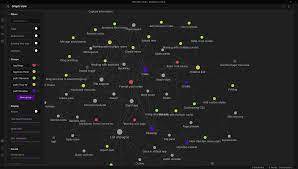 Obsidian allows people to link their ideas together, forming a mindmap
Obsidian allows people to link their ideas together, forming a mindmap